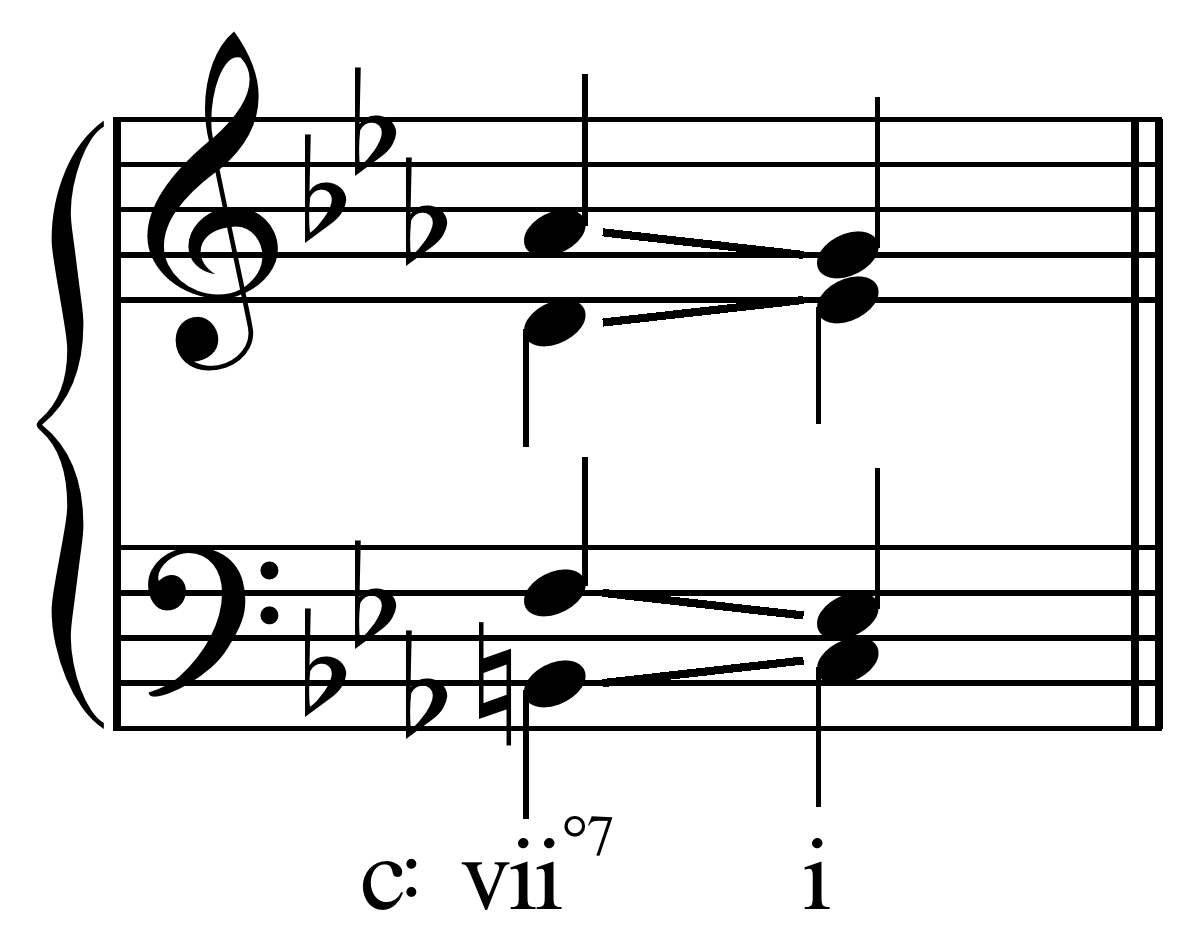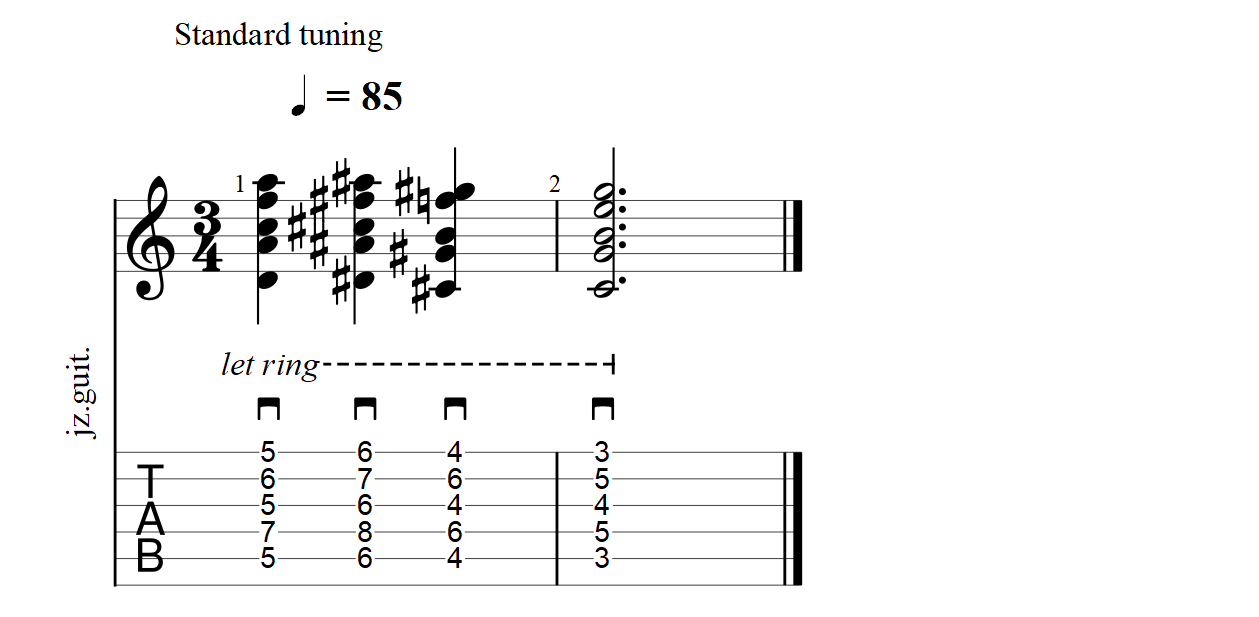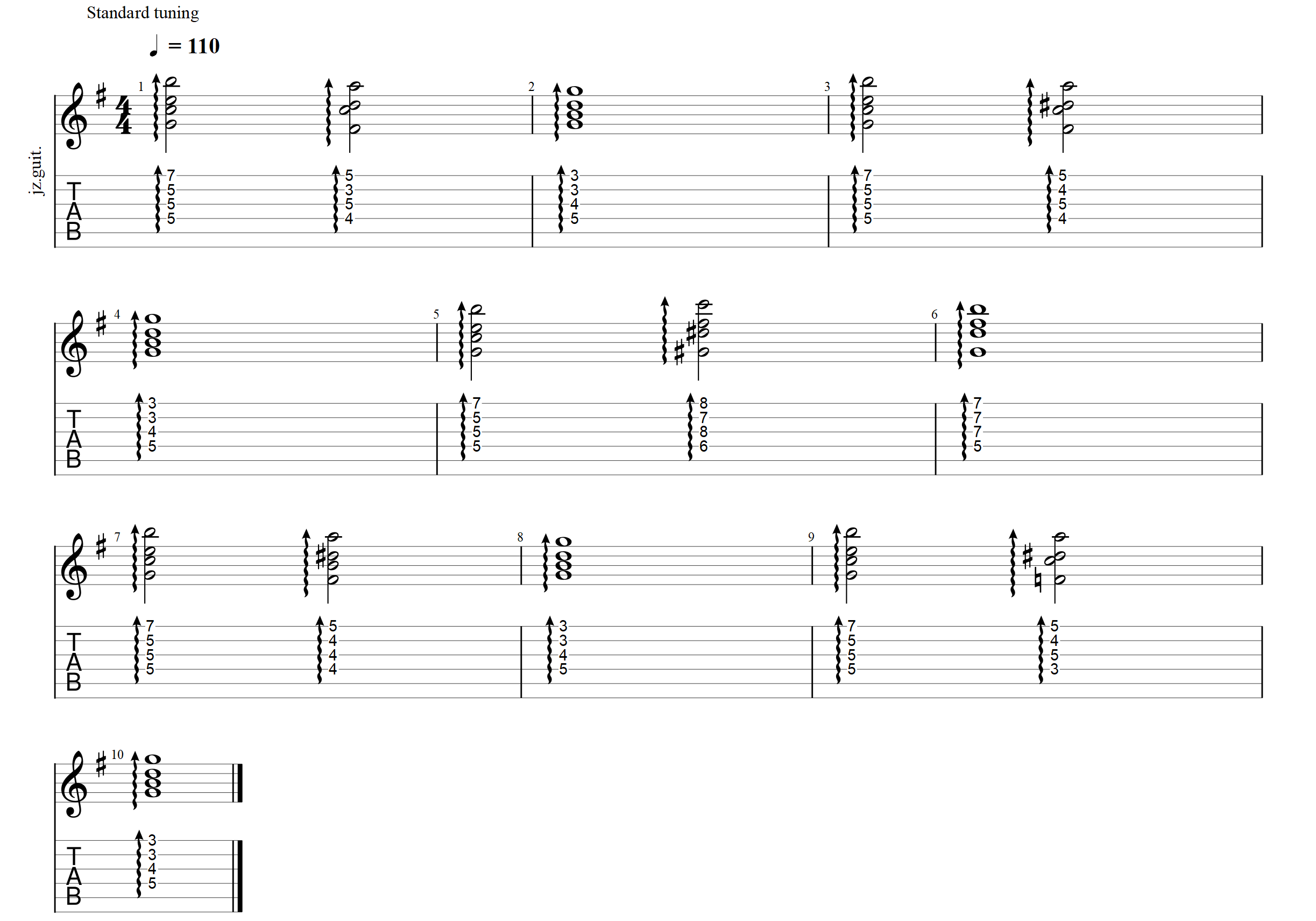Note: This post is for those who possess the basics of music theory. 或者您还可以读后记
1. The diminished seventh chord
Introduction
Diminished seventh chord, as its name suggests, is a diminished triad with a diminished seventh stacked on the top of the root, or a modified half-diminished seventh chord with its seventh lowered a semitone. The chord is featured by its dissonant and unpleasant sound. If we build a diminished seventh chord with B as its root, the four notes will be B, D, F, and Ab.
This chord is seen diatonically only in harmonic minor scale, and not diatonic in all the seven modes, which means in most occasions, this chord has at least one note that is not in the key in which the music is playing.
One of most important property of diminished seventh is its symmetry. Because diminished seventh chord is composed of three stacked minor thirds, its four inversions are composed of the same pitch classses. This means that if we look at a random diminished seventh chord, take one note out of the four, and build another diminished seventh chord with the chosen note as its root, the new chord will be composed of exactly the same set of notes as the original chord.
The following example demonstrates the point:
- Bdim7 (B-D-F-Ab)
- Ddim7 (D-F-Ab-B)
- Fdim7 (F-Ab-D-F)
- G#dim7 (G#-B-D-F)
As you can see, since G# is enharmonically equivalent to Ab, there is no difference between the four chords execpt for their roots.
Functions
Serve as a dominant chord
The most common use of the diminished seventh chord is probabaly the extension of the diminished seventh triad, which resolves to the tonic. The diatonic VII triad in a major key is B dimished triad(composed of B, D, F), which shares two common notes with the V triad(composed of G, B, D). Therefore, it is usully used to replace the V-I chord progression with VII-I. By stacking a diminished seventh on the top, we add more dissonance and tension to the dominant chord.
In natural minor scale, the II is a diminished triad, which also resolves to tonic harmonically, so the diminished seventh is also used in this case.

The diminished seventh chord resolution in C harmonic minor
Secondary dominant
Used as a burrowed chord that has a dominant function. For example, a IV-V-I chord progression in C majoy would be F-G-C. If we replace the F with a secondary dominant chord, the chords will be F#dim7-G-C. The more detailed explanation will not be included.
Modulation
Just like how the V chord can be used for circle modulation, so does the diminished seventh chord. Since the chord is the seventh of a major scale and the second of a minor chord, we can techanically modulate from any orignal keys to the targeted major key by playing a diminished seventh chord with its root a semitone below the tonic, or to the targeted minor key by playing a diminished seventh chord with its roots a major second above the tonic.
With the property of symmetry, we can go even further. Right now we already know a diminished seventh chord can lead us into two keys: a half step above the root and a whole step below. With its symmetry, we know that one diminished seventh chord is equivalent to three other diminished seventh chord. This means, each diminished seventh chord can actually go to eight different keys if we include the inversions.
This function is well explained in a youtube video made by the beloved youtuber, Signals Music Studio. (a round of applause)
2. Tritone subsitution
Introduction
Tritone subsitution is one of the most common chord subsitution found in jazz music, which also leads to other more complex subsitution like the Coltrane changes. Although known as the augmented sixth chord in the classical world, the tritone subsitution were not often heard until munch later in the 1940s.
The tritone subsitution basically states that you can replace a dominant seventh chord with another dominiant seventh whose root is a tritone away the original chord. For example, a G7 can be replaced with with a Db7 chord. (Db is a tritone away from G).
The most common usage of the tritone subsitution is the twelve-bar blues, which is one of the most prevalent chord progression in the world of jazz music.
| C7 | F7 | C7 | C7 | F7 | F7 | C7 | C7 | G7 | F7 | C7 | C7 |
| C7 | F7 | C7 | Gb7 | F7 | F7 | C7 | C7 | G7 | F7 | C7 | C7 |
Notice that the first line is the simpler form of the progression and the second line repeat the progression except using the tritone subsitution on the fourth chord, from C7 to Gb7.
The second most common usage is in the classic II-V-I jazz standard.
Orignal: Dm7-G7-Cmaj7
Altered: Dm7-Db7-Cmaj7
As you can see the tritone subsitution is applied to the V, which creates a natural passing base composed of D-Db-C.

Here is a more detailed example with chord progression Dm7-Ebm7-Db7-Cmaj7.
It can be interpreted that the piece briefly modulates to the key of Db as Ebm7 happens to be the second degree, and the Db7 replaces G7 when it leads to the tonic.
Justification
The jazz narrative
In standard jazz harmony, the tritone subsitution works because the two chords have two pitches in common: the third and the seventh.
G7: G-B-D-F
Db7: Db-F-Ab-B
As you can see the B and the F is inherited by the altered chord.
Additionally, when you use tritone subsitution to resolve to the tonic, the two altered notes, though creating dissonance, have a stepwise motion toward the notes of the tonic, which causes a smooth voice leading.
As you can see in the previous example I presented, the Ab goes down a half step to G, and the Db goes down a half step to C. This voice leading would be erroneous in the eye of a classical musician because it creates a parallel fifth, but again, this is just the jazz narrative.
The classic narrative
Different from the jazz harmony which calls it the tritone subsitution, the classical harmony would notate the subsitution as an augmented sixth chord. There are three kinds of augmented sixth chord:
Italian sixth It+6
Enharmonically equivalent to a dominant seventh without a fifth
German sixth Gr+6
Enharmonically equivalent to a standard dominant seventh
French sixth Fr+6
Enharmonically equivalent to the Lydian dominant without a fith but with a sharped eleventh.
Note that all the chords above serve as a function of pre-dominant, which is a subsitute for the secondary dominant of V, versus in jazz such subsitution is often used a the domiant.
Also the note that the German sixth, the one that is most widely used for the tritone subsitution in jazz, creates parallel fifth in voice leading naturally. In response the classical musicians either appease this error or use the Italian or the French sixth for replacment.
My narrative
When I toggled the chords on intruments, I noticed something different from the narrative of the majority, which also justifies the use of tritone subsitution. This method involves the function of diminished seventh chord I mentioned above.
Replacing dominant seventh with diminished seventh
Other than the fact that both dominant seventh and diminished seventh create tension and dissonance, it is easy to notice that, given any dominant seventh chord, if we raise the root by a half step and keep all the other notes, we will get a diminished seventh chord.
G7: G-B-D-F
Abdim7: Ab-B-D-F
Converesly, with the property of symmetry, if we lower any one out of the four notes in a diminished seventh chord, we will get a dominant seventh chord with the lowered note as its root.
The result is, in a lot of the occassions, the two chords are interchangable since they are so similar in terms of their compositions. For example, you can replace the V in a standard II-V-I chord progression with a diminished chord whose root is a half step above. Though not admitted in the classical world, this conversion sounds approximately the same in practice.

Notice the second playthrough does not sound too much different from the first.
If we apply this conversion to both the substituted chord and the substitute chord, the result is the same diminished seventh chord, which justfies the method.
A more complex method is by converting the subsitute chord alone:
Orignal: Dm7-G7-Cmaj7
Tritone subsitution: Dm7-Db7-Cmaj7
After conversion: Dm7-Ddim7-Cmaj7
Notice here that the Ddim7 can be interpreted as a burrowed chord from the parallel minor scale.
Now, we can justfiy the tritone subsitution through a chain of evidence.
- Ddim7 is a burrowed chord from the parallel minor that resolves to tonic.
- Ddim7 is another form of Db7.
- Db7 is the tritone subsitution of G7.
Therefore, we can conclude that Db7 can replace G7.
3. Implications
In the case of tritone subsitution, we lowered one note of a burrowed diminished seventh chord by a half step. However, because of its symmetrical property, it also should make logical sense to lower the two other notes.
The result of the experiment is as follow:

The music above summarizes all the variations. The chords are:
Orignal: Cmaj7-D7-Gmaj
Dim7 version: Cmaj7-F#dim7-Gmaj
Tritone subsitution: Cmaj7-Ab7-Gmaj7
Lower the fifth: Cmaj7-B7-Gmaj
Lower the root: Cmaj7-F7-Gmaj
Note that the B7 can be interpreted as a burrowed chord from parallel natrual minor and the F7 can be seen as a secondary dominant that resolves to the sixth, and we are using the tonic to replace the sixth since they have lots of notes in common.
END.
后记
终于通宵写完了这篇博客。已经早八点了。
这是目前为止,我写的篇幅最长,最费力的文章。字儿本身可能不太多,但是每张图都要找很久。要是想借图,那得注意copyright。要是自己作图,就要用专门的音乐软件把曲子写出来,然后以图片的形式导出,再放进对应的folder里。音频文件则是要upload到一个第三方平台上,然后在用这个平台的embedded feature把code嵌入到源代码。要是想微微改动,那以上的流程就要重新再走一遍。以此反复,感觉自己就跟《变形记》里的主角一样。
虽然写了很多东西,但是都只是我作为一个业余爱好者的课余所学。若是一个专业的音乐生来读,恐怕能指出这篇文许许多多的漏洞。若是真的有,请务必告知。